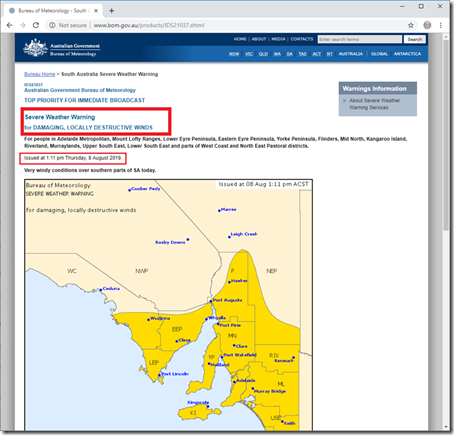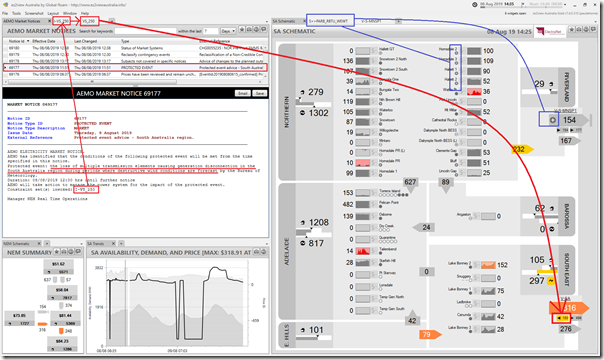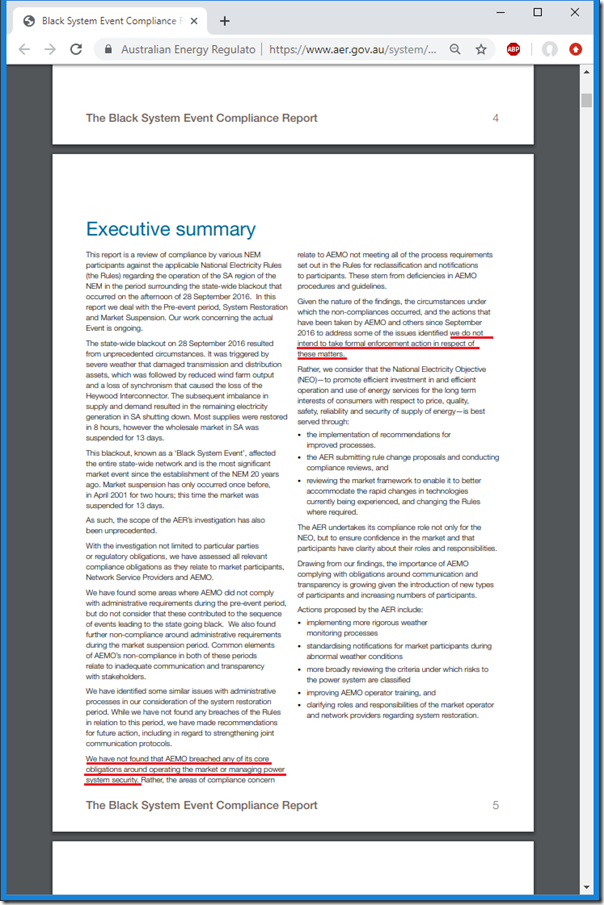Quite coincident today that there are effectively two different types of storm warnings present affecting the South Australian region (amongst others) of the National Electricity Market – one literal, and one figurative:
(A) The literal storm warning
At 13:11 today the Bureau of Meteorology issued Severe Weather Warning IDS21037 noting “damaging, locally destructive winds” across much of the state:
Taking this into account, AEMO published Market Notice 69177 at 11:51 of a “Protected Event” because of a risk of “the loss of multiple transmission elements causing generation disconnection in the South Australia region during periods where destructive wind conditions are forecast by the Bureau of Meteorology.”
As noted here in the snapshot from ez2view at 14:35 this afternoon, the AEMO invoked Constraint Set “I-VS_250” which operates with Constraint Equation “VS_250” to limit the maximum flow west from Victoria into South Australia to no more than 250MW (i.e. providing headroom for a rapid increase in flow west should generation disconnect in South Australia, dropping the frequency as a result).
We see that the dispatched flow is heading east on the Heywood interconnector at the time, with the high wind speeds powering most wind farms up near their maximum capacities:
Note that some wind farms (along with other assets) are being limited by the “S>>PARB_RBTU_WEWT” constraint equation, related to the trip of Robertstown-Tungkillo 275kV line. The affected elements are shown with “+” and “-” symbols on the schematic.
For those a little rusty, Jonathon Dyson’s introduction to (frequency responses and) FCAS is a useful refresher to understanding how frequency responds to sudden changes to supply (or demand).
Intentionally limiting the interconnector flow in advance of a possible contingency event (e.g. some operational generators in SA tripping for reasons related to the high wind speeds, directly or indirectly) is one of the approaches that has been used more frequently in the wash-up following the SA System Black back on 28th September 2016. We need to keep in mind that this does have a cost (i.e. leading to more expensive generation operating in some instances), but the decision has been made that this cost is outweighed by the benefits of added system security:
The list of references to the SA System Black provided here might be useful to some readers – and please add comments on that page if you know of others.
(B) The metaphorical storm warning
Coincident with the current-day physical system storm warning today, yesterday we saw notice of another (bigger) storm brewing, this time in a figurative sense, with the announcement that AER has commenced proceedings in the Federal Court against four wind farm operators for alleged breaches of the National Electricity Rules (NER).
Proceedings have been brought against subsidiaries of:
- AGL Energy Limited (ASX: AGL) in relation to the Hallett 1, Hallett 2, Hallett 4 and Hallett 5 Wind Farms (Suzlon turbines);
- Neoen SA in relation to the Hornsdale Wind Farm (Siemens turbines);
- Pacific Hydro Pty Ltd in relation to the Clements Gap Wind Farm (Suzlon turbines); and
- Tilt Renewables Limited (ASX: TLT) in relation to the Snowtown 2 Wind Farm (comprising Snowtown Wind Farm Stage 2 North and Snowtown Stage 2 South Wind Farm) – Siemens turbines.
This decision has certainly surprised many people for a number of reasons – including because of what’s been inferred from the “we do not intend to take formal enforcement action in respect of this matters” statement from the AER itself in the Executive Summary of their their own “The Black System Event Compliance Report” published 9 months earlier on 14th December 2018:
Note that various others have inferred, with respect to this AER statement:
Caveat #1) That this statement seems to refer to AEMO only (given that it is the primary actor mentioned in the paragraphs above); and, more significantly;
Caveat #2) That this event report covered the Pre-event, System Restoration, and Market Suspension aspects surrounding the 28 September 2016 event – but not the Event itself (they note, on the page before that “The AER’s work surrounding the actual Event is ongoing and is therefore not a focus of this report.”)
2a) I am currently unaware of an AER Report on the Event itself being published in the 9 months since the release of this report;
2b) It would seem logical (with court action proceeding) that this report should be available at the same time?
2c) If anyone knows where it is, I would like to link it into this list of key reference documents about the SA System Black (so please contact me directly, or leave a comment on that page).
Now let me be clear that I am not in the best place (nor am I the best person) to be commenting on the court action itself or the specific parties involved – hence I am intentionally NOT doing so in the following comments. Readers should take the clear hint also not to read anything like that into the following …
The metaphorical storm clouds that are gathering seem, to me, to be massing for storms at two different levels:
(B1) Re-ignition of “the Energy Wars”
In reality they never really went away, though perhaps the atmosphere did cool a little after the crescendo of that particular RET Review.
However it’s been only 36 hours or so since the publication of the AER announcement, and already I’m sensing a marked escalation of thunder and lightning amongst a broad group of commentary in mainstream media, in specialist niche media brands (i.e. energy sector focused, like WattClarity), and in an eclectic assortment of corners of social media… This time it might even be worse, in a way:
(a) With a federal coalition government (with certain elements particularly re-energised after winning the “unwinnable” election) and a deflated opposition licking its wounds after losing the same; and
(b) Throwing in an enquiry into nuclear just to make the mixture truly challenging.
Continuing with the electrical analogies, I expect that after much heat and noise has been generated in the process, we’ll look back (once again) and see that not much useful work will have been actually been performed.
As you can probably tell, I’m pretty pessimistic about this storm – given the motley collection we have of emperors with no clothes, our own confused crowd of us as the voting public, and a the far-too-influential rumps at both extremes of the Emotion-o-meter, whilst all the while that train continues hurtling down the track.
(B2) A reasoned discussion (rather than a religious battle, I would hope) about Generator Performance Standards
There is a lower altitude storm that is also amassing that might actually end up doing something useful – in terms of washing away much obscurity and confusion relating to the purpose, the nature, and the content of Generator Performance Standards.
Again note that:
1) I am not commenting about the specific nature of the court action itself,
2) Nor am I commenting about the actors involved;
3) Nor am I commenting about the System Black event
…. but it does occur to me that there may be a flow-on benefit in this particular storm, if it leads to a genuinely reasoned and detailed discussion (and heightened awareness) about the specifics of what we need to expect that generators will be able to provide (and the standards under which they do this) into the future of our energy transition. Perhaps I am naively optimistic about what might actually be achieved outside of the attention of the broader gaggle of stakeholders that seem to be swarming into the energy sector?
It was only in yesterday’s article that I noted that we’d explored (in Theme 14 within Part 2 of the Generator Report Card) how we all need much better mental models of both the electricity grid and its intertwined (but still distinct) electricity market. The ones we have grown up with are, even if we’ve been in the industry for decades, are struggling to keep up with the growing complexities.
This is particularly challenging for new entrants:
(a) At the downright scary end of the spectrum, we have been told stories of prospective generators who have been confused between the NEM’s GPS (i.e. Generator Performance Standards) and the more widespread use of GPS (Global Positioning System) – even at the point where their projects had secured significant funding (from who?!) and were into construction. Would be downright funny if it was not so scary…
(b) In Theme 5 within Part 2 of our Generator Report Card, we explore how there’s an emerging schism between “us” and “them” in the NEM that is leading to a growing gap in organisational capability (as distinct from capacity) amongst stakeholders in the NEM. We hypothesise that this is due, at least in part, because of the specific mechanisms used to support “Anytime/Anywhere Energy”.
Let’s hope that the people most affected in this particular storm can approach it with a mindset of building a NEM 2.0 that actually delivers an energy transition that works (as distinct from what we’ve been witnessing over the past 10-15 years).
I’ll be watching this particular storm with interest (whilst trying to avoid being pounded ‘cats and dogs’ in the Energy War Storm)…





1. The decision to reduce flows on long distance transmission in the face of storms is common in many jurisdictions and had the practice been followed before the system black it would not have happened. Between 100 and 150 MW of gas generation around Adelaide would have solved the problem.
2. The anti-renewables rhetoric may delay the transition at the margin but economics will win so before the end of this government non hydro renewables will provide more energy than gas and brown coal combined and black coal will fall below 45% of total generation